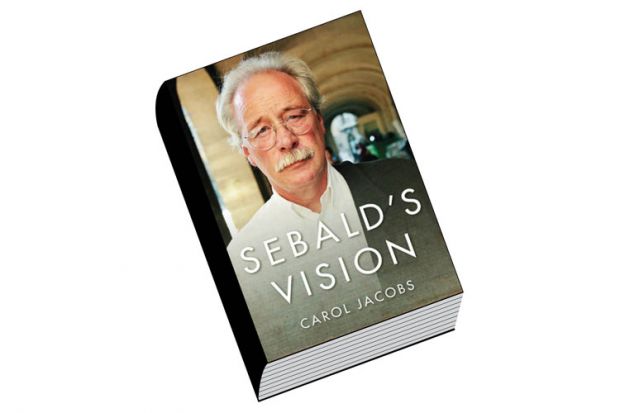W. G. Sebald’s literary body of work – not novels, as Carol Jacobs reminds us in her new study – is a staple of comparative literature courses. What would Sebald, whose eponymous narrator in Austerlitz notably deplores the “inexorable spread of ignorance even to the universities”, have made of this fact? Or of the industry of academic criticism that now addresses this former literary critic, who died in 2001?
I confess to having once been a minor worker bee, drawn to the richness of Sebald’s writing. One of the most memorable figures in his four stories in The Emigrants is the “butterfly man”: can one pin down the essence of this wide-ranging writing, which traces the tragic history of modernity’s effects in its complex narrative forms of pseudo-biography, travel writing and Holocaust remembrance?
Images of eyes are woven throughout his work. Here they are again, Sebald’s melancholic eyes peering at us – questioningly? – through round glasses on the cover of Jacobs’ book. This is her angle: Sebald’s angular (and perhaps Walter Benjamin-influenced angelic) gaze upon the world. In one of the book’s many Sebaldian touches, Jacobs attributes her title to a friendly interlocutor. Her focus on the gaze does indeed offer a striking insight into Sebald’s complex representations of history. While Jacobs largely treats his work as a coherent oeuvre, she reworks the chronology of publication to weave together her argument in a final discussion of one of the author’s well-known collaborations, that with the artist Jan Peter Tripp. Although Jacobs always has new insights to offer, her book is particularly refreshing in such less familiar sections, as opposed to the more customary set pieces such as The Rings of Saturn’s discussion of Rembrandt, and The Emigrants’ Łódź section. At times, her argument about Sebald’s “indirect” gaze upon the objects of his contemplation takes on a persuasive and suggestive force beyond the confines of its single-author frame.
Although it is inevitable that a study of Sebald will tend towards a specialised audience, Jacobs avoids the traps of the contemporary academic industry, eschewing jargon and an overburdened scholarly apparatus. One gains the impression of an author confidently and generously conversant with an otherwise unwieldy academic terrain, and yet following her own patient path. Jacobs recalls Sebald’s excoriation of overtheoretical Kafka scholarship, and writes from an empathetic stance, albeit one that is heavily reliant on interviews with Sebald in aiming to be “in tune” with his project. This provokes larger questions about academic writing, which Sebald, of course, renounced in order to pursue his creative path. His narrative layers are so complex, perpetually self-undoing in line with his unique, oblique vision, that definitive judgements are hard to make. This rather irritatingly infects Jacobs’ style, with a penchant for serial sentences beginning “perhaps”, an imitation of Sebaldian sentence structures that leave one twisting like a red herring on some allegorical Suffolk beach.
With its important focus on the question of perception, and its high-visibility publisher, Jacobs’ book will doubtless make a long-lasting contribution to Sebald criticism. She does, however, have a tendency to cite the works and then largely re-cite them via her analysis, which left this reader yearning not only for the real thing (in German), but also for a perspective as radical as that offered by Helen Finch in Sebald’s Bachelors, viewing his work via the lens of queer theory.
Simon Ward is lecturer in German, Durham University.
Sebald’s Vision
By Carol Jacobs
Columbia University Press, 296pp, £27.50
ISBN 9780231171823 and 1540100 (e-book)
Published 22 September 2015
Register to continue
Why register?
- Registration is free and only takes a moment
- Once registered, you can read 3 articles a month
- Sign up for our newsletter
Subscribe
Or subscribe for unlimited access to:
- Unlimited access to news, views, insights & reviews
- Digital editions
- Digital access to THE’s university and college rankings analysis
Already registered or a current subscriber? Login




